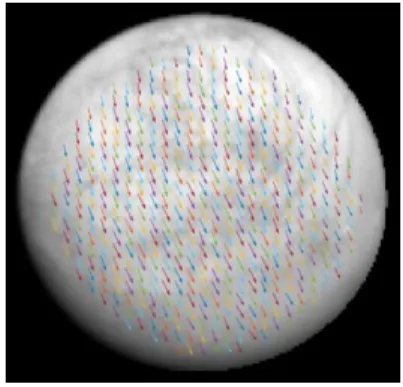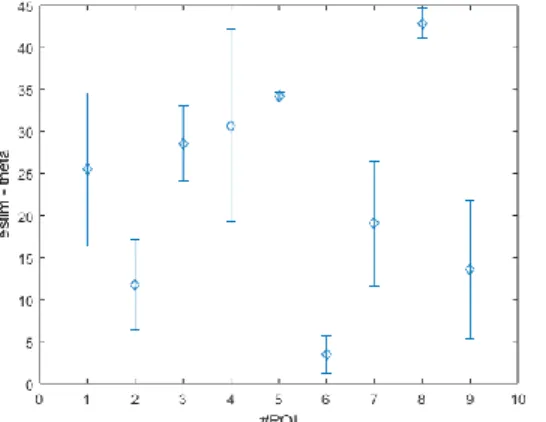HAL Id: hal-02902855
https://hal.archives-ouvertes.fr/hal-02902855
Submitted on 20 Jul 2020
HAL is a multi-disciplinary open access
archive for the deposit and dissemination of
sci-entific research documents, whether they are
pub-lished or not. The documents may come from
teaching and research institutions in France or
abroad, or from public or private research centers.
L’archive ouverte pluridisciplinaire HAL, est
destinée au dépôt et à la diffusion de documents
scientifiques de niveau recherche, publiés ou non,
émanant des établissements d’enseignement et de
recherche français ou étrangers, des laboratoires
publics ou privés.
Photometric study of Europa with Hapke model
Ines Belgacem, Frederic Schmidt, Grégory Jonniaux
To cite this version:
Ines Belgacem, Frederic Schmidt, Grégory Jonniaux. Photometric study of Europa with Hapke model.
European Planetary Science Congress, Sep 2018, Berlin, Germany. �hal-02902855�
Photometric study of Europa with Hapke model
Ines Belgacem (1), Frédéric Schmidt (1) & Grégory Jonniaux (2)
(1) GEOPS, Univ. Paris-Sud, CNRS, University Paris-Saclay, rue du Belvédère, Bat. 504-509 Orsay, France, (2) Airbus Defence & Space, Toulouse, France (contact: ines.belgacem@u-psud.fr)
Abstract
In the context of ESA’s future mission JUICE, this work is the start of a broad investigation on the reflectance models of Jupiter’s icy moons. It focuses on Europa and Hapke photometric model using images from the LORRI instrument on New Horizons. The parameters are estimated using a Bayesian approach that has been developed for similar work on Mars. We show that it is possible to constrain Hapke parameters on restricted areas of Europa and that they can be fairly different depending on the regions of interest. However, this study shows limitations that we hope to overcome by including more data from other missions such as Voyager.
Introduction
The JUICE (JUpiter ICy moons Explorer) mission from the European Space Agency (ESA) is scheduled to launch in 2022 and arrive at the Jovian system in 2030 to study Jupiter and its icy moons for three and a half years. The spacecraft is being designed by Airbus Defence & Space in Toulouse, France, with a new and innovative navigation system. Any mission to the outer Solar System is challenging considering local radiative and thermal conditions as well as the distance to the Earth. The vision-based navigation algorithm implemented on JUICE will make the spacecraft more autonomous and more precise in its pointing by extracting navigation data from on-board image processing [1]. To offer the best of that algorithm, the spacecraft needs to have a proper knowledge of the photometric models of the moons that will be observed.
Significant work has been done using the Voyager and telescopic observations [2, 3, 4]. But none of these models give satisfying results when simulating images and comparing them to reality. This work aims at studying local photometric properties with the Hapke model [5].
1. Data set
We are using images taken by the LOng Range Reconnaissance Imager (LORRI) on the New Horizons spacecraft. Using [6] we adapted the calibration process to Europa, extracted the measured radiance and converted it to reflectance in REFF units.
2. Method
2.1 Correction of meta-data
Before anything else, it is essential to correct the images metadata. We have corrected for spacecraft pointing errors as well as moon attitude inaccuracies. To do so, we simulated images using the image renderer developed by Airbus DS, SurRender [7]. Among other things, it allows for custom reflectance model input which is very useful for our study. We used meta-data downloaded on the NASA PDS [8] for the simulations and we compared them to the real images. We then computed the corrections in pointing to make them match using an optimization-based registration function. The attitude of the moon was ultimately refined by computing the optical flow between simulated and real images. The registered movement (fig. 1) was converted to rotation.
Figure 1: Example of optical flow on image EPSC Abstracts
Vol. 12, EPSC2018-358, 2018
European Planetary Science Congress 2018 c
With accurate meta-data, each pixel was projected onto the moon so the observing geometry – incidence, emission and phase angle – could be computed for all.
2.2 Model and Bayesian Inversion
For this study we are considering Hapke direct model detailed in [5]. Six parameters are to be estimated: b, c, ω, θ, h and B0.
We constrained these parameters in selected areas of Europa using a Bayesian approach that has been used on Mars in the past [9]. No a priori knowledge of the parameters were inferred except for their physical domain of variation. A Monte Carlo Markov Chain algorithm was used to sample the Probability Density Function (PDF) of the a-posteriori solution [9, 10]. The sampling algorithm has been optimized recently [11].
3. Preliminary results
We conducted this local study on nine different zones of interest. Results are rather homogeneous for ω but show some variation for parameters b, c and θ. Fig. 2 shows the distribution for the latter. Since we don’t have any data with phase angles lower than 20°, it is impossible to draw any relevant conclusion for h and B0.
Figure 2: Variation of θ over the different regions of interest
Conclusion
This study shows that we can constrain Hapke parameters on restricted areas of Europa. Thus, local photometric studies should be determined on this moon after additional work. However, we noted that
we would need more data to gain confidence in these results and extend the study.
We are working to add data from the Voyager spacecrafts as well as any relevant images from the Cassini and Galileo missions. Because these datasets are very different, each brings its own set of challenges, but we are confident this should help us constrain the photometric properties of Europa and, ultimately, those of Ganymede and Callisto. We will also investigate other photometric models and compare their best fit to fulfill our objective of deriving accurate reflectance models for all three icy moons.
Acknowledgements
This work is supported by Airbus Defence & Space, Toulouse (France) as well as "IDI 2016" project funded by the IDEX Paris-Saclay, ANR-11-IDEX-0003-02.
References
[1] G. Jonniaux and D. Gherardi (2014), Robust Extraction of Navigation Data From Images For Planetary Approach and Landing, 9th ESA GN&CS conference.
[2] B. J. Buratti and J. Veverka, Voyager Photometry of Europa, Icarus, 1983.
[3] D. Domingue and B. Hapke Disk-Resolved Photometric Analysis of European Terrains, Icarus, 1992.
[4] B. J. Buratti, Photometry and Surface Structure of the Icy Galilean Satellites Journal of Geophysical Research, 1995. [5] B. Hapke, Theory of reflectance and emittance spectroscopy. Topics in Remote Sensing, Cambridge University Press, 1993
[6] F. Morgan et al. Calibration of the New Horizons Long-Range Reconnaissance Imager, Astrobiology and Planetary Missions, 2005.
.
[7] R. Brochard and N. Despré, SurRender - Image generation software for scientific-level space scene simulation, IPPW 13, 2016.
[8] A.Cheng , NEW HORIZONS Calibrated LORRI JUPITER ENCOUNTER V2.0, NH-J-LORRI-3-JUPITER-V2.0, NASA Planetary Data System, 2014
[9] J. Fernando et al. Surface reflectance of Mars observed by CRISM MRO: 2. Estimation of surface photometric properties in Gusev Crater and Meridiani Planum, Journal of Geophysical Research, 2013.
[10] J. Fernando, F. Schmidt, and S. Douté, Martian Surface
Microtexture from Orbital CRISM Multi-Angular
Observations: A New Perspective for the Characterization of the Geological Processes Planetary and Space Science, 2016. [11] F. Schmidt and S. Bourguignon, Efficiency of BRDF sampling and bias on the average photometric behavior Icarus, 2018 (under review)

